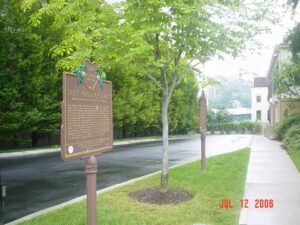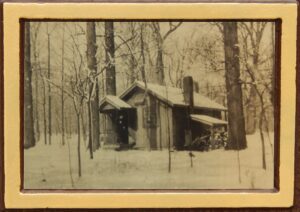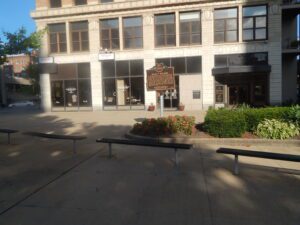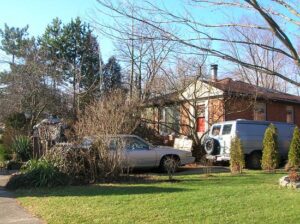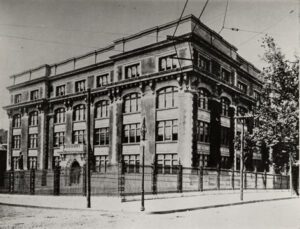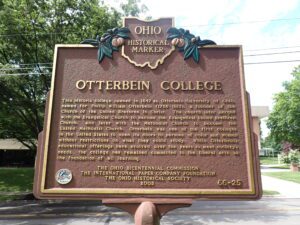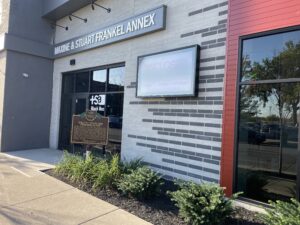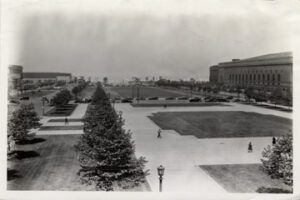, OH
The first African American artist to achieve international acclaim, painter Robert S. Duncanson (1821-1872) was born in New York and settled in Cincinnati in 1840. He pursued his artistic career during a time of tremendous racial prejudice and was acknowledged as the “best landscape painter in the West.” Arts patron Nicholas Longworth commissioned murals from Duncanson around 1850 for his home Belmont, now the Taft Museum of Art; these paintings are regarded as one of the finest pre-Civil War domestic decoration schemes in the United States. Sponsored by anti-slavery groups, he traveled widely during the 1860s in Europe. Duncanson rose above oppression to create expressions of African American cultural identity, leading the way for other people of color to pursue careers in the arts.
, OH
“The Poet’s Shack” was built as a writing studio for the prolific poet Percy MacKaye, who held the position of writer-in-residence at Miami University from 1920-1924. MacKaye requested a writing studio in the woods, a simple shack with a fire where faculty and students could gather to talk with the poet or hear his newest works. MacKaye’s studio was built on Miami’s lower campus — now known as Bishop Woods after first president Robert Hamilton Bishop — where Upham Hall stands today. Students called the structure “The Poet’s Shack.”
, OH
The figure atop the Soldiers’ Monument has looked over Youngstown’s Central Square since 1870. Ohio Governor David Tod began campaigning for a monument for Youngstown’s fallen soldiers even before the Civil War ended. The community raised $15,000, and the cornerstone was laid in 1868. The memorial was completed and dedicated on July 4, 1870, with Governor Rutherford B. Hayes and Congressman James A. Garfield, both future U.S. presidents, attending the ceremony. Four cannons procured by Garfield formerly surrounded the monument. In 1951 the figure on the pedestal was accidentally damaged. A new statue of Carrara marble was commissioned, sculpted in Italy, and installed in 1955. The Bertolini Bros., a local marble firm, donated the new figure, which as patterned after the original, as their gift to the city.
, OH
The ARK in Berea is the first structure in Cuyahoga County to incorporate sustainable building concepts from the Earth Summit in Rio de Janeiro in 1992. Hand built in 1994 as a work of art by environmental artists David and Renate Jakupca, it is a study for future buildings for the Headquarters of the International Center for Environmental Arts (ICEA) and Eco Village. A hybrid structure utilizing cob, straw bales, aluminum cans, used tires, and recycled construction materials, the ARK (Architektur Recycled Kulturstall) helps to address the environmental problems of large urban areas and the trend of rebuilding rather than remodeling existing structures. The ARK is used as a museum, community center, and art studio of David Jakupca.
, OH
William and Abigail Cutter Woodward founded Woodward High School, the first public high school west of the Allegheny Mountains, on this site October 24, 1831. Concerned that the poor of Cincinnati had no avenues for education, the Woodwards donated land, time, funding, and expertise to this venture that brought the arts and sciences to “those who have not the means of procuring such advantages themselves.” Notables include Dr. Joseph Ray, principal, 1851-1855, author of several popular mathematics texts; Professor William McGuffey, author of the well-known readers and spellers; and William Howard Taft, Class of 1874, former U.S. President. From 1856-1863, the home of Levi and Catherine Coffin was also located on this site. Both were legendary abolitionishts who helped enslaved people escape to freedom in Canada. Levi is often referred to as the “President of the Underground Railroad.”
, OH
This historic college opened in 1847 as Otterbein University of Ohio, named for Philip William Otterbein (1726-1813), a founder of the Church of the United Brethren in Christ. The church later merged with the Evangelical Church to become the Evangelical United Brethren Church, and later with the Methodist Church to become the United Methodist Church. Otterbein was one of the first colleges in the United States to open its doors to persons of color and women without restrictions on what they could study. While Otterbein’s educational offerings have evolved over the years to meet society’s needs, the college has remained committed to the liberal arts as the foundation of all learning.
, OH
Willys-Overland Finishing Plant. Since 2004, the building at 14th and Adams Streets has been the home of the Toledo School for the Arts. The Willys-Overland Corporation erected the building c. 1916 to finish, ship, and sell the company’s cars. The popular Whippet and other models were delivered here to a second story loading dock from the Willys plant along what became Jeep Parkway. Vehicles were displayed behind floor-to-ceiling windows in a first floor showroom. The firm of Mills, Rhines, Bellman, and Nordoff designed the building and others in Toledo during the first third of the 20th century. In 1908, John North Willys (1873-1935) consolidated his company’s automobile production in Toledo. By 1912, Willys-Overland sales were second only to the Ford Motor Company’s. The company’s most famous product is the Jeep, which transported Allied service members from WWII to the 1980s and was a precursor to the sports utility vehicle.
, OH
In August 1903, architects Daniel H. Burnham, John M. Carrere, and Arnold W. Brunner presented Mayor Tom L. Johnson and the City of Cleveland a plan that epitomized the City Beautiful Movement in America. The Group Plan envisioned a grand landscaped mall surrounded by public buildings in the Beaux-Arts style. The plan would create a monumental civic center, influence the design of buildings throughout the city, and lay the foundation for a city planning commission. The first of its kind in the nation, the Group Plan, as built, was the most completely realized of Burnham’s city planning efforts. In its green space and architecture, the Mall remains an enduring and vital element of Cleveland’s civic culture. (continued on other side)


